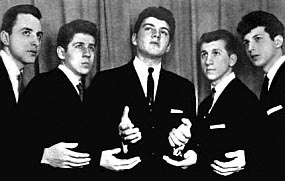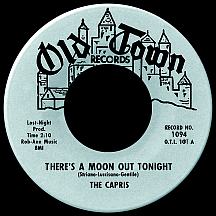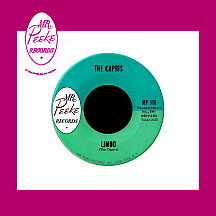THE CAPRIS
There's a Moon Out Tonight
You might say the course taken by The Capris played out in threes. To start with, it took three different label releases for the Queens quintet's first single to catch on outside the New York area. In addition, they performed together in three separate decades and three original members remained with the act throughout. None of this was intentional, as the group's success came largely by accident; just a little more than two years after the struggling Planet label pressed up several hundred copies of "There's a Moon Out Tonight," the song became a major factor in keeping many street corner vocal harmony acts vital well beyond their presumed late-'50s expiration dates.
Tenor Mike Mincieli began singing with baritone Vinnie Naccarato and bass John Apostol in 1957; within a few months, Nick Santamaria had joined as the all-important lead vocalist (a position vacated by Rosario Morice in the early going). Completely unaware of Philadelphia's Capris (an R&B group that had been recording for the Gotham label since '54 with a female lead, Rena Hinton), the Ozone Park high schoolers named themselves after the Lincoln Capri (Ford's "Hot Rod Lincoln," immortalized in song by Charlie Ryan). By the summer of 1958 another tenor, Frank Reina, completed the quintet. Their harmonies were strong and time was booked at Bell Sound in New York; "There's a Moon Out Tonight" and its uptempo flip, "Indian Girl," were recorded and picked up by Planet with songwriting noted on both sides as Al Striano, Joe Luccisano and Alfonso Gentile, though there are doubts as to who actually penned the songs.
The group performed at dances and in some N.Y. clubs, but there was no interest whatsoever in the record; lack of promotion on the part of Planet Records didn't help. The Capris fell apart; Nick joined the Army, Mike got married....and the name kept popping up! Jesse Belvin had a single in '59 on the Tender label with backing by a Capris group while another unrelated Capris single mysteriously appeared on Sabre...and there were one or two others. Philly's Capris had disbanded a short time earlier.
At ths point the scene shifts to Times Square Records, a retail store that was owned by Irving "Slim" Rose and located on 42nd Street at the bottom of a set of stairs leading to the Manhattan subway. The so-called vocal group "revival" that kicked in around 1960, jump-starting the "oldies" movement (even if some of the music wasn't that old) and, by association, the later proliferation of oldies-format radio stations, has often been acknowledged as originating at this centrally-located record shop (though west coaster Art Laboe can also claim credit due to the first of his Oldies But Goodies albums from the previous year). Jerry Greene, an employee at Times Square, picked up a copy of the Capris' Planet disc and, having a close friendship with rhythm and blues aficionado Alan Fredericks of the Night Train show on WADO-AM (the shop sometimes ran commercials on the station), he talked the jock into playing the single on his show one night in the summer of 1960. Listener reaction was positive.
Jerry ran out and made a deal with Planet Records for the rights to the masters; they gave him a stack of Capris 45s, which he sold at the shop for about 200 bucks each, about as much for one record as the total amount he'd paid Planet...guess they just didn't understand how things are with the frenzied collector subculture! When those ran out, he and three business partners created a record label, Lost-Nite, for the purpose of meeting demand (those 45s sold for less than a buck); soon he was getting the rights to release dozens of 1950s doo wop discs on what turned out to be a trailblazing cult reissue label (Slim Rose even got in on the action by starting his own Times Square label). "There's a Moon Out Tonight" blew up in the Big Apple after its Night Train exposure; WABC, WMGM and WINS' Murray the K all jumped on it. Greene couldn't handle the demand for tens of thousands of copies, so he in turn sold the rights to Hy Weiss at Old Town Records, a label that had been successful the previous couple of years with hit singles by Robert and Johnny, The Fiestas and Billy Bland. It turned out to be an easy sell. The Capris' two-year-old "Moon" song hit the Billboard charts in December and reached the top ten in February '61.

So what about the five youthful harmonizers who made the actual recording? Nick Santamaria, discharged from the Army and back in Queens, heard the song on the radio and quickly got the guys back together. Good move, because Hy Weiss was looking for them. They were suddenly back in the studio doing new material (in stereo for a change!) and performing in big auditoriums like the Apollo in Harlem and Chicago's Regal Theater. "Where I Fell in Love," a well-executed if unexciting ballad, with writer credit designated to all five under the Capris name (they'd learned their lesson on that count and Weiss was accommodating), appeared on the national charts for a few weeks in March and April. The similar "Tears in My Eyes" came up short as the third Old Town effort. Ironically, they did a nice version of a '56 hit by The Cliques, which featured a lead vocal by Jesse Belvin of one of the other Capris outfits they'd never heard of. "Girl in My Dreams" appeared briefly on the charts that fall, but Weiss had a short fuse and bounced them from the Old Town roster.
Santamaria left the group soon afterwards and attempted a solo career as Nick Santo. No breaks came his way and in 1965 he began a long tenure with the N.Y. police department. The other members made a record for the oddball Mr. Peeke label; "Limbo" took a Tokens-type approach to the shimmy-under-a-stick dance craze led by Chubby Checker and made a minor chart appearance in August 1962. Then the act broke up...again.
Third time's a charm! Nick Santamaria, Mike Mincieli and Frank Reina basically skipped the '70s and regrouped in 1981 after realizing a whole new revival was in the works. Baritone Tony Dano and bass singer Tom Ferrara (of Dion's backing group The Del-Satins) filled the other two spots. They recorded "Morse Code of Love" (Nick got the writer credit this time) for Ambient Sound, an early-'80s doo wop throwback label (for the flip side, they couldn't resist unashamedly reconstructing their huge hit as "There's a Moon Out Again"). The uptempo number (faithful to the sound of the Old Town recordings from 20 years earlier) was a big part of their live shows for many years. In 1985, The Manhattan Transfer remade the song (faithful to the Capris' arrangement) as "Baby Come Back to Me (The Morse Code of Love)," helping the third phase of The Capris' spotlight-time outlast either of the first two.



